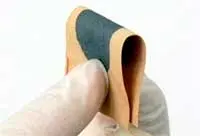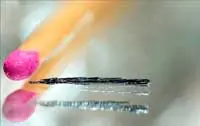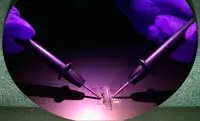Electronics News
Archive : 28 November 2016 год
 A method for depositing graphene based inks onto cotton, developed by by researchers from the University of Cambridge and Jiangnan University, could enable the creation flexible and wearable electronics without the use of expensive and toxic processing steps.
A method for depositing graphene based inks onto cotton, developed by by researchers from the University of Cambridge and Jiangnan University, could enable the creation flexible and wearable electronics without the use of expensive and toxic processing steps.
In the process, developed by a team led by Dr Felice Torrisi at the Cambridge Graphene Centre, cotton textiles are impregnated with a graphene-based conductive ink.
According to the team, most current wearable technologies rely on rigid electronic components mounted on flexible materials. These can offer limited compatibility with the skin, can be damaged when washed and are uncomfortable to wear.
“Turning cotton fibres into functional electronic components can open an entirely new set of applications – from healthcare and wellbeing to the IoT,” said Dr Torrisi.
“Other conductive inks are made from precious metals, such as silver, which makes them expensive to produce and not sustainable, whereas graphene is cheap, environmentally-friendly and chemically compatible with cotton.”
Professor Chaoxia Wang of Jiangnan University noted: “This method will allow us to put electronic systems directly into clothes. It’s an incredible enabling technology for smart textiles.”
According to the researchers, a wearable strain sensor created using a graphene-coated smart cotton textile, has been shown to detect up to 500 motion cycles reliably after more than 10 washing machine cycles.
Author
Graham Pitcher
Source: www.newelectronics.co.uk
 École polytechnique fédérale de Lausanne (EPFL) scientists have developed a perovskite material whose magnetic order can be rapidly changed without disruption due to heating. This material could be used to build next generation hard drives.
École polytechnique fédérale de Lausanne (EPFL) scientists have developed a perovskite material whose magnetic order can be rapidly changed without disruption due to heating. This material could be used to build next generation hard drives.
"We have essentially discovered the first magnetic photoconductor," said postdoctorate student Bálint Náfrádi.
The researchers have synthesised a ferromagnetic photovoltaic material whose magnetic properties can be modified, without changing the structure of electrons in the material's chemistry or crystal structure.
This new crystal structure combines the advantages of both ferromagnets, whose magnetic moments are aligned in a well-defined order, and photoconductors, where light illumination generates high density free conduction electrons.
With these two properties, a simple red LED is said to be enough to disrupt, or ‘melt’, the material's magnetic order and generate a high density of travelling electrons, which can be freely and continuously tuned by changing the light's intensity. The timescale for shifting the magnetic in this material is also very fast.
Although still experimental, these properties mean that the new material could potentially be used to build the next generation of memory storage systems, featuring higher capacities with low energy demands.
"This study provides the basis for the development of a new generation of magneto-optical data storage devices," added Náfrádi. "These would combine the advantages of magnetic storage – long-term stability, high data density, non-volatile operation and re-writability – with the speed of optical writing and reading."
Author
Peggy Lee
Source: www.newelectronics.co.uk
 A research team from the National Institute of Standards and Technology (NIST) has come up with a way to build safe, nontoxic gold wires onto flexible, thin plastic film. Their demonstration potentially opens the way for wearable electronic devices that monitor health.
A research team from the National Institute of Standards and Technology (NIST) has come up with a way to build safe, nontoxic gold wires onto flexible, thin plastic film. Their demonstration potentially opens the way for wearable electronic devices that monitor health.
"Overall this could be a major step in wearable sensor research," said NIST biomedical engineer Darwin Reyes-Hernandez.
Reyes-Hernandez was exploring a porous polyester membrane to see if its tiny holes could make it useful for separating different fluid components. He patterned some gold electrodes onto the membrane to create a simple device that would help with separations.
By complete chance, he twisted the plastic a few times and noticed the electrodes which covered numerous pores as they crisscrossed the surface still conducted electricity. This wasn't the case with nonporous membranes.
"Apparently the pores keep the gold from cracking as dramatically as usual," Reyes-Hernandez explained. "The cracks are so small that the gold still conducts well after bending."
According to the researchers, the electrodes show even higher conductivity than their counterparts on rigid surfaces – an unexpected benefit which cannot yet be explained.
"This thin membrane could fit into very small places," Reyes-Hernandez concluded. "Its flexibility and high conductivity make it a very special material."
Author
Peggy Lee
Source: www.newelectronics.co.uk

